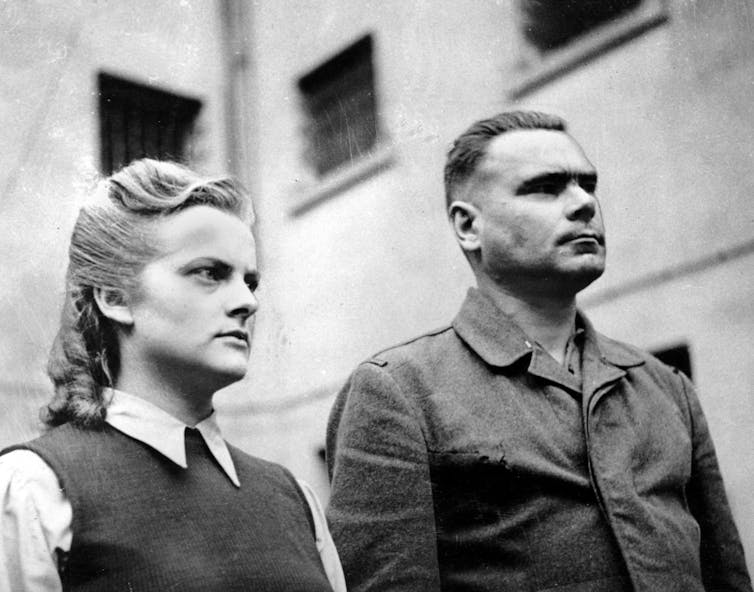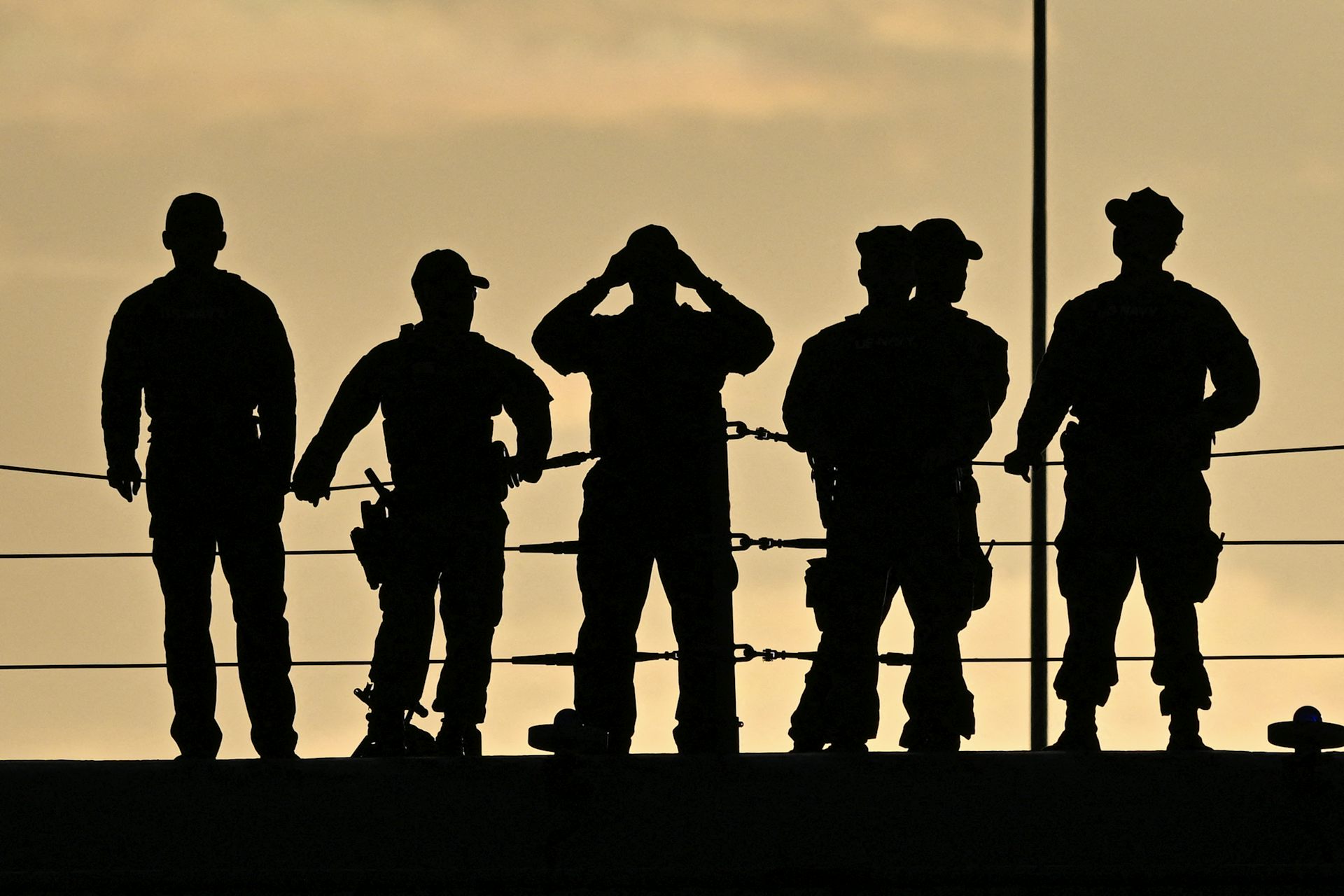How women wage war – a short history of IS brides, Nazi guards and FARC insurgents
Hundreds of thousands of women helped the Nazi cause. Few ever faced justice.
The names of American-born Hoda Muthana and Brit Shamima Begum have appeared in countless headlines in the United States and Europe since these two female members of the Islamic State group were discovered in a large displaced persons camp weeks ago.
The women were among the holdouts in Islamic State’s last stronghold in Baghouz, Syria. When they were found by journalists, one was pregnant and the other was caring for her young child.
In the four years that these women lived as part of IS, they went from a self-described idyll in IS’s capital, Raqqa, to fleeing airstrikes with little more than the clothes on their backs. Now, as young mothers, they have been held up as iconic IS brides, evidence of the group’s ability to distort the minds of vulnerable teenagers.
In numerous interviews, these two women have wholeheartedly adopted this narrative.
“When I went to Syria, I was just a housewife for the entire four years – stayed at home, took care of my husband, took care of my kids,” Begum told Sky News. Although Muthana incited the murder of Americans on Twitter, according to these women’s accounts they did not take part in Islamic State’s violence. They did not even see it.
A history of impunity
We’ve heard this story before.
As Wendy Lower meticulously details in “Hitler’s Furies: German Women in the Nazi Killing Fields,” roughly half a million German women followed their husbands or volunteered to settle the territory conquered by Nazi Germany in Eastern Europe. Women on the Eastern Front were integral to the expansion of the Nazi state, serving in key administrative, logistical and medical roles.
Some of these Nazi women also perpetrated horrific crimes. As many as 5,000 served as concentration camp guards. Roughly 10,000 women were SS auxiliaries, or Helferinnen, serving in a bureaucracy that murdered millions in the gas chambers of Auschwitz and elsewhere. A total of 7,900 women were employed in the SS Frauenkorps, where those working as secretaries would often decide which political prisoners ended up on the day’s kill lists. Thousands more Nazi nurses assisted in heinous medical experiments and euthanasia.
Yet, like most of the women in IS, Nazi women did not engage in armed combat. They clung to the gender roles and identities that National Socialism had created for them as wives and mothers.
As the Third Reich collapsed around them, most Nazi women in the East fled and returned to their former lives in Germany. Of the few who were apprehended, only a small portion ever faced justice. Following a military trial, the United Kingdom executed one such woman – Irma Grese, a 22-year-old Bergen-Belsen guard. But the vast majority of Nazi women were never held to account for their crimes, in Germany or abroad.

Insurgent women
The roles carved out for women in Islamic State and Nazi Germany as wives and mothers, first, and perpetrators of violence, second, differ from the experiences of most women in armed groups.
In “Insurgent Women: Female Combatants in Civil Wars,” Alexis Henshaw, Ora Szekely and I detail women’s participation in conflicts in Colombia, Ukraine and the Kurdish regions of the Middle East. Women in rebel groups in these contexts often participate in combat, in addition to communications, logistics and other support roles.
In Colombia’s FARC, women were first mobilized with their families as the wives of fighters. Only later were women permitted to take up arms, eventually constituting between 30 and 40 percent of the FARC’s fighting force. Unlike IS, which encouraged women to give birth to grow the population of the caliphate, the FARC heavily regulated women’s fertility and sexual relations. Forced abortions and abandoned children were accepted as a cost of victory.
In contrast, many women who took up arms against the Ukrainian military in the Donbas region of eastern Ukraine did so precisely because they were mothers. Women in these pro-Russian separatist groups often say they are fighting to protect their families and their homeland, having been abandoned by men who are avoiding conscription by both sides of the conflict.
Yelena Dustova, a 39-year-old mother of three, said, “What, should I allow them to shoot at me in my town? No. I will stand here so that they won’t be allowed to pass. I have my mom and kids in there.”
As our book “Insurgent Women” details, rebel women in the Donbas see no tension between their duties driving tanks, staffing checkpoints or serving as snipers and their roles as daughters, mothers and wives.
Holding women accountable
Women’s roles in armed groups vary. But, in large part due to their ability to blur the line between civilian and combatant, women’s often unseen contributions to conflict can be key to an armed group’s success.
The mobilization of more than 4,700 women like Shamima Begum and Hoda Muthana by IS was unprecedented because they were foreign. But women’s participation in violent projects to remake their societies is more common than we realize.
Tens of thousands of Nazi women escaped justice. This historical precedent should be considered as governments decide how they will hold the women of IS to account for their crimes.
Jessica Trisko Darden is a Jeane Kirkpatrick Fellow at the American Enterprise Institute.
Read These Next
RFK Jr. wants to scrutinize the vaccine schedule – but its safety record is already decades long
Federal officials are questioning the safety of the vaccine series children receive. Here’s the story…
Deception and lies from the White House to justify a war in Venezuela? We’ve seen this movie before
Two US wars based on lies, in which tens of thousands of American troops and millions of civilians died,…
Miami’s new mayor faces a housing affordability crisis, city charter reform and a shrinking budget
Eileen Higgins won a hard-fought election to become Miami’s new mayor. Now for the hard part – governing…






